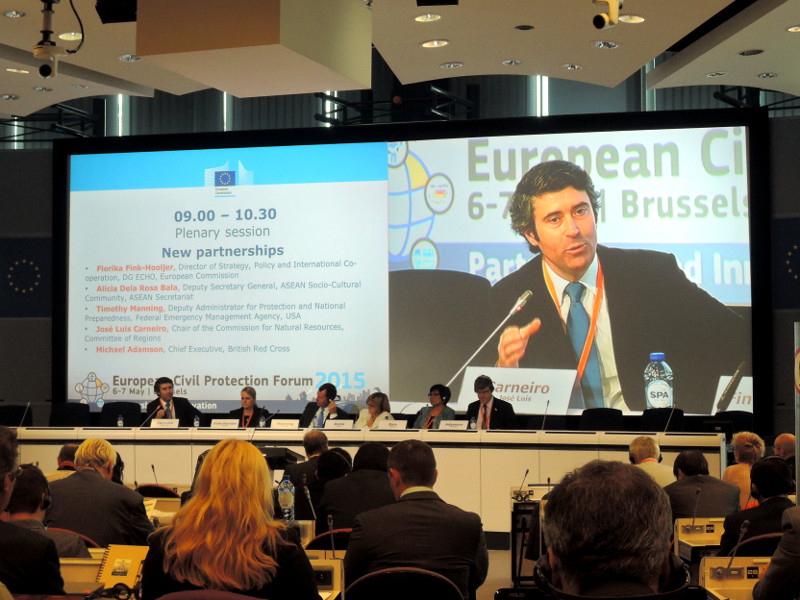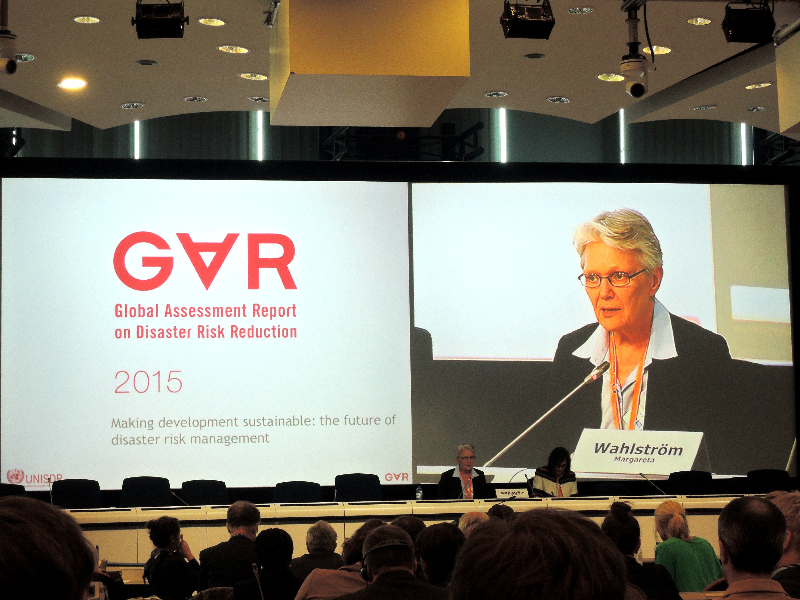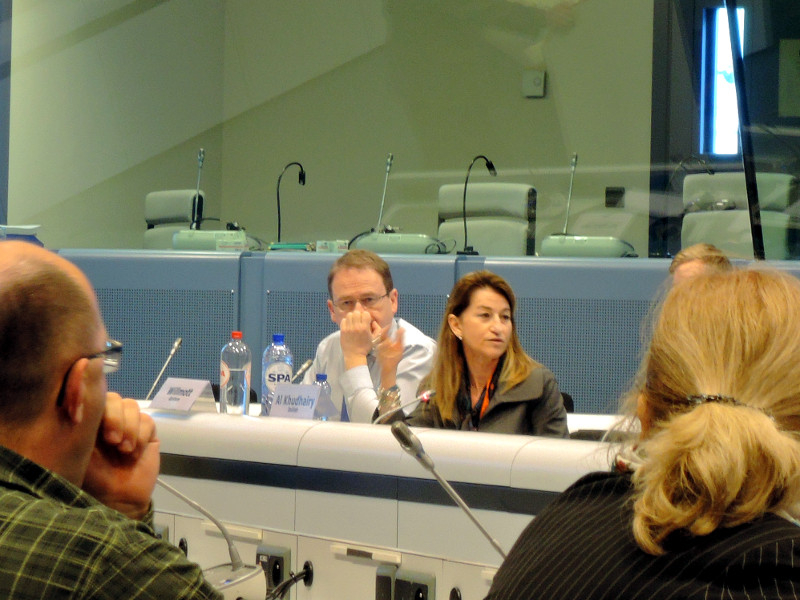EU Civil Protection Forum: New partnerships and latest developments
Posted on |
At the European Civil Protection Forum 2015 from 6-7 May in Brussels, civil protection stakeholders from Europe and the world talked about new opportunities for cooperation in European cross-border civil protection and the latest developments in this area on the European level.

The conference featured a wide range of topics, from experiences and best practices in resilience of structures and citizens over new opportunities for partnerships to new concepts and technologies. These issues were discussed over the course of two conference days.
The opening plenary on partnership and innovation in disaster management featured Margareta Wahlström, Head of UNISDR, Elisabetta Gardini, MEP, Walter Deffaa, Director General Regional and Urban Policy of the European Commission, and Monica Scatasta from the European Investment Bank. After the plenary the audience divided into the first round of panels.
Resilience for citizens and infrastructure
75% of the EU’s population live in urban areas. Natural disasters hit a particularly large number of people if they affect cities. The panel titled “Understanding resilient cities” discussed EU-financed disaster prevention projects as a mean to this risk. However, also cities that do not lie within typical risk areas can be affected by the ever more frequent extreme weather events, as Christian Kromberg, deputy mayor of the city of Essen clarified. Several panellist agreed that strengthening the cooperation with the private sector in disaster prevention and preparedness is important and discussed how this could be achieved. Jack Radisch from the OECD’s High Level Risk Forum appealed to private enterprises with the argument that supporting disaster prevention and preparedness would also help to mitigate the economic cost of a disaster.
A lively discussion on how citizens could be made aware of the disaster risks in their region and thus be made more resilient was the focus of a panel called “Empowering resilient citizens”. Maria Telhado from the civil protection authority of Lissabon made clear, that first of all resilience eduaction requires appropriate funding. Other panellists, like Christina Andersson from the Swedish Civil Contingencies Agency MSB stressed that, in addition, the proper pedagogical approach has to be discussed. The participants exchanged good practices and remaining challenges from their own countries.There was general agreement that covering disaster resilience in schools is absolutely necessary. A quick show of hands from the audience confirmed this unanimously. Yet, not all European countries include disaster resilience in their school curricula at this time. Keiko Tamura, professor at the Risk Management Office at Niigata University in Japan, presented the results of a study which proved the success of such education: Complications and serious damages due to earthquakes and tsunamis were less severe in Japanese schools with resilience education on their curricula.

After the completion of the panels, the first conference day ended with Margareta Wahlström presenting the Global Assessment Report on Disaster Risk Reduction to the plenary.
New partnerships
The morning of the second day was dedicated to the elaboration on new and improved possibilities for partnerships, with panels on the linking of international actors in disaster management, partnering with the private sector and science-based disaster management.
At the panel titled “Science-based disaster risk management” Merle Missoweit from Fraunhofer INT presented the DRIVER project, which works on integrating scientific methods into disaster management. However, the discussion often came back to one crucial point: As Andy Kirkman from the UK Met Office as well as Scira Menoni from Politecnico de Milano remarked, knowledge is not a mean in itself in civil protection. It has to be brought to the attention of the target group and be made usable to them. In some cases the problem might be lack of access. Delilah Al Khudhairy from the European Commissions’s Joint Research Centre was well aware of the problem. At the moment, the Commission is trying to counter it with a knowledge centre platform for their research programmes. Members of the audience expressed concern that the data is often not structured in a way that makes them practically applicable to end users. In response, input from end-users was explicitly invited by Graham Wilcott from DG Home.
The panel on “linking international disaster management actors”, started by drawing a general picture of the challenge of ever more complex crises. Juha Auvinen, Head of DG ECHO’s Emergency Response Unit, and Jesper Lund from UN OCHA explained, that communication and interoperability are still a challenge in international cooperation. The panellists stressed that an important focus should be put on the affected people on the ground, who are often the factual first responders, particularly in places where international aid arrives late or not at all. It is necessary to educate and train them in risk assessment, as to help them to gather relevant information for national as well as international disaster relief workers. An incomplete picture of the situation is a common problem when preparing international deployments. Other difficulties that have to be addressed locally include infrastructure and its coordination. Ian Norton from the WHO joined the panel live from Nepal and reported from the difficulties at Kathmandu airport. The delivery of aid materials was delayed as the airport struggled to coordinate the sudden rise in traffic due to aid organisation’s flights.
“Partnering with the private sector”, as another panel was titled, was a recurring issue at the Civil Protection Forum. Ed Martinez from the UPS Foundation and Andrea Debane from the Airbus Foundation laid out their existing cooperation with aid organisations. A remark from the audience stressed that a lack of public trust in private enterprises should be kept in mind when talking about public-private partnerships in civil protection. Jérôme Glorie from the Belgian Ministry of Home Affairs illustrated the motivation of private entities to cooperate with an example from Antwerp: There, a chemical company co-financed a special fire-fighting truck for chemical leaks and fires. The vehicle is beneficial to operational safety on the company’s premises as well as to the community as a whole.
Innovative technologies
The afternoon sessions were focused on innovation in three different aspects of disaster relief: New technologies in the field, innovative partnerships in training and crisis communication.

“Innovation in the field” was debated by a mixed panel of researchers, manufacturers and users of new technologies such as unmanned aerial vehicles (UAVs, “drones”). With the developments of recent years, some achieved in the context of EU projects, the effective usage of UAVs in disaster relief is not a technical problem any more. As Henrik Bendixen from the Danish company Sky-Watch stated, the problem is a legal one. EU-wide legislation to allow for their usage in disaster relief is not possible, as the creation of such rules falls within the competency of the member states, as Vincente de Frutos Cristóbal from DG Mobility and Transport remarked. Geert de Cubber, coordinator of the EU-funded ICARUS project, criticised that this legal uncertainty does not only hamper the deployment of current technology, but also deters investors from funding further research and development.
In the panel on “Crisis communication” interaction with the public through social media and similar channels was a primary concern. As such, the panel gave a specific example of the integration of the public debated in earlier panels. The most ambitious project, presented by its co-founder Patrick Meier, was the “Digital Humanitarian Network”. Digital Humanitarian uses crowdsourcing to get damage reports and mapping from crisis regions. Local people can participate with their mobile phones. Panellists from different civil protection authorities reported about their social media usage. The fire fighters in Antwerp have gone as far as trusting alarms reaching them exclusively via social media, should they be independently confirmed by several people, as the city’s emergency manager Bart Bruelemans explained. Katja Evertz from BBK said that civil protection authorities in Germany are still faced with a lot scepticism about social media. In particular, the public is concerned about data protection.
Event recordings available online
The full programme as well as recordings of the plenaries and panels of the Civil Protection Forum are available on the website of the European Commission.

